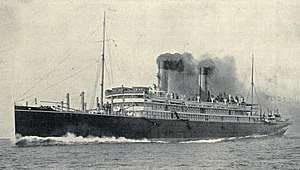SS Tenyo Maru
SS Tenyo Maru (天洋丸, Tenyōmaru) of the Toyo Kisen Kaisha Steamship Co. (TKK) was a Japanese ocean-going passenger liner completed in 1908 by the Mitsubishi Dockyard & Engine Works, Nagasaki, Japan. It had a sister ship SS Chiyo Maru. It had accommodation for 275 first-class, 54 second-class and 800 steerage passengers, and could carry over 8000 tons of cargo.[1] The steerage class had an opium den for Chinese passengers.[2] The ship had the following dimensions: length overall 575 ft., between perpendiculars 558 ft., breadth 63 ft., depth to shelter deck 46 ft. 6 in., to upper deck 38 ft. 6 in., gross tonnage 14,700 tons; displacement 21,500 tons at 31 ft. 8 in. draught.[3]
 | |
| History | |
|---|---|
| Name: | SS Tenyo Maru |
| Owner: | Toyo Kisen Kaisha |
| Builder: | Mitsubishi Dockyard & Engine Works, Nagasaki |
| Launched: | 1908 |
| Fate: | Scrapped in 1933 |
| General characteristics | |
| Tonnage: | 14,700 gross register tons (GRT) |
| Length: | |
| Beam: | 63 ft (19 m) |
| Draught: | 31 ft 8 in (9.65 m) |
| Depth: |
|
| Installed power: | 17,000 HP at 270 rpm |
| Propulsion: | Triple expansion steam engine |
| Speed: | 20 knots (37 km/h) |
| Capacity: |
|
The ship's turbines were built by the Parsons Marine Steam Turbine Company, Wallsend, England, in 1907, and were capable of delivering a total 17,000 hp at 270 revolutions per minute. It had three 12-inch hollow-steel shafts, each carrying one propeller, with pitch of 105 inches, diameter of 115 inches. Steam was supplied by 13 cylindrical boilers, working at 180 lb pressure and fired by oil fuel only. The ships attained 21.6 knots on trial and 20 knots on ocean service.[1]
History
Tenyo Maru was designed with ship building ideas of contemporary naval architecture throughout the world; its Japanese engineers visited shipyards internationally and adopted the best ideas they found. It took the place of the Nippon Maru,[4] built by Sir J. Lang of Sunderland, England in 1898, which was 421 feet long, 50 feet 7 inches wide and 29 feet 7 inches deep.[5]
Tenyo Maru was launched in 1908 from Nagasaki, Japan, as the first Turbine Steam Ship built for trans-Pacific passenger service. It made its first arrival in San Francisco on June 30, 1909, from Manchuria,[6][7] the first of many crossings which brought immigrants from Asia through the United States Immigration Station, Angel Island. Tenyo Maru was the first turbine driven steamship ever in the port of San Francisco.[8] A model of the ship was on display at the De Young museum in San Francisco, where it was that museum's largest steamship scale model.[9]
On September 27, 1910, while en route from Hong Kong to San Francisco, via Yokohama and Honolulu, Tenyo Maru ran aground thirty miles from Shanghai. The ship was floated at high tide with the aid of tugboats, without serious damage, and was able to continue its voyage.[10] In February 1913, Tenyo Maru weathered a storm which began 3 days into the voyage and lasted 6 days, which destroyed the ship's gangway, and smashed its rails; at times, the waves dashed over the smoke stacks. The 115 first and second class passengers were kept below decks while the captain made the decision to ride out the storm by heaving to, which was very unusual in a large steamship.[11]
In 1921, the ship was fumigated due to a first-class passenger who became suddenly ill and died June 28 while en route from Nagasaki to Kobe. The passenger had bubonic plague. The cause was determined to be exposure to infected fleas from rats aboard the vessel.[12]
Tenyo Maru was the ocean liner that carried the Japanese Friendship Dolls from Yokohama to San Francisco in 1927.[13] It also carried opium and contraband. When Tenyo Maru arrived in San Francisco on July 9, 1929, passenger Sui'e Ying Kao, wife of the Chinese Vice Consul, requested that her baggage be passed and delivered at once, claiming diplomatic immunity from Customs inspection. The agents did not agree, broke the seals, opened the trunks, and found 2,300 cans of opium (about 1,000 pounds), worth about $600,000, making it a very large seizure by contemporary standards.[14]
The ship was scrapped in 1933[15] and is not the same ship as the similarly named Japanese fishing vessel Tenyo Maru which collided with the Chinese freighter Tuo Hai within Canadian Territorial waters on July 22, 1991, causing a serious oil spill.[16]
References
- Watts, Philip (1911). . In Chisholm, Hugh (ed.). Encyclopædia Britannica. 24 (11th ed.). Cambridge University Press. p. 887.
- http://staff.haas.berkeley.edu/barde/_public/immigration/phr%20essay%20review.pdf
- Ensign W.S. Anderson, U.S. Navy, "S. S. TENYO MARU.: TURBINE MACHINERY AND OIL-BURNING BOILERS", Journal of the American Society for Naval Engineers, Volume 20, 1908, pp. 670-673.

- San Francisco Call, Volume 103, Number 83, 21 February 1908
- San Francisco Call, Volume 84, Number 94, 2 September 1898
- https://www.archives.gov/files/research/microfilm/m1410.pdf
- San Francisco Call, Volume 104, Number 17, 17 June 1908
- San Francisco Call, Volume 104, Number 3, 3 June 1908
- DeYoung museum catalog, p132, 1921.
- Sacramento Union, Number 37, 28 September 1910
- Sacramento Union, Number 45, 14 February 1913
- Annual Report of the Surgeon General of the Public Health service of the United States, for the fiscal year 1922. Page 166.
- Gordon, Bill. "Steamship Tenyo Maru". wgordon.web.wesleyan.edu.
- "National Affairs: Mrs. Kao's Catastrophe," Time Magazine, Monday, July 22, 1929
- RBCM Archives. "The SS Tenyo Maru, scrapped in 1933". search.bcarchives.gov.bc.ca.
- "F/V Tenyo Maru Fuel Oil, Diesel and Lube Oil Spill". www.cerc.usgs.gov. U.S. Department of the Interior's (DOI) Natural Resource Damage Assessment and Restoration Program (NRDAR Program). Retrieved 6 October 2017.
![]()